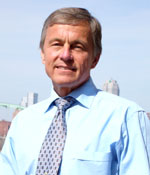
In the lab of McGowan Institute for Regenerative Medicine deputy director Stephen Badylak, DVM, PhD, MD, professor of surgery, University of Pittsburgh, and director of the Center for Pre-Clinical Tissue Engineering within the McGowan Institute, the major focus is the development of regenerative medicine strategies for tissue and organ replacement. The utilization of mammalian extracellular matrix (ECM), or its derivatives, as an inductive template for constructive remodeling of tissue is a common theme of most research activities.
“If you asked anybody 25 years ago about the function of the extracellular matrix, they would’ve said it was structural,” says Dr. Badylak. “Now it’s the opposite: it’s recognized as a reservoir of signaling molecules that serves as a sort of information highway between cells.”
By the mid-1980s, Dr. Badylak had begun to explore whether healthy matrices stripped of their cells could be used to stimulate tissue regeneration in animals. This stripping process, dubbed decellularization, involves treating tissues with a mix of chemicals, including detergents and enzymes, to remove cells while leaving the matrix intact.
Although ECMs vary from tissue to tissue, therapeutic materials can originate from different organs or even different species. For some tissues, it almost doesn’t matter what ECM is used, Dr. Badylak says; for others, “it definitely makes a difference.”
For instance, matrices from the pig small intestine, bladder or dermis can all repair human skeletal muscle. But for the esophagus, only an ECM from the same tissue will suffice. And, in the central nervous system (CNS), a foreign matrix works better than a nervous system one. Dr. Badylak’s team found that urinary bladder ECM stimulates neuronal stem cells to proliferate better than an ECM derived from the CNS.
In their project on CNS Tissue Engineering, the objective of the Badylak Lab’s present and future work is to develop an effective substrate for reconstruction of functional CNS tissue. We believe that the ECM provides such a substrate and can “jumpstart” regeneration of CNS tissue either by recruitment of endogenous stem cells to the site of injury or by placement of such stem cells within a scaffold that is placed at the injury site.
Jyoti Madhusoodanan reports in her Nature article on Dr. Badylak’s and others’ work and the ECM and how it governs a surprising number of cellular functions. New science techniques are revealing how cells and matrix communicate — and why this cross-talk matters.
